PIB Headquarters
INTERNATIONAL DAY OF NON-VIOLENCE
प्रविष्टि तिथि:
01 OCT 2025 11:15AM by PIB Delhi
Key Takeaways
- October 2 is celebrated as Gandhi Jayanti and globally as the International Day of Non-Violence, as declared by the United Nations – a dual tribute that reflects both national pride and global respect for the Mahatma.
- The UN General Assembly adopted a resolution in June 2007 affirming non-violence as a universal principle and promoting a global culture of peace and tolerance.
- The spirit of Gandhi Jayanti and the International Day of Non-Violence is kept alive globally, with commemorations held in countries such as Belgium, USA, Spain, Serbia, Switzerland, Thailand, Kazakhstan and the Netherlands.
Introduction
On October 2, the world honours the birth of Mahatma Gandhi. In India, the day is celebrated as Gandhi Jayanti, while across the globe it is observed as the International Day of Non-Violence, following a 2007 United Nations resolution that received support from over 140 countries. This dual observance gives the day a unique significance that is rooted in India’s national memory yet shared as a universal message for humanity.
At the UN, the day is observed with statements from the Secretary-General and events that connect Gandhi’s philosophy to today’s realities. In recent years these messages have pointed to the conflicts across the globe and have reminded nations that Gandhi’s belief in truth and non-violence is “more powerful than any weapon.”
In India, the observance takes the form of tributes at Raj Ghat, cultural and educational programmes, and public campaigns that highlight Gandhi’s ideals. Over the years, these commemorations have gone beyond ceremonial gestures to inspire national missions — from the Swachh Bharat Abhiyan that promotes cleanliness, to the revival of Khadi and rural industries symbolising self-reliance.
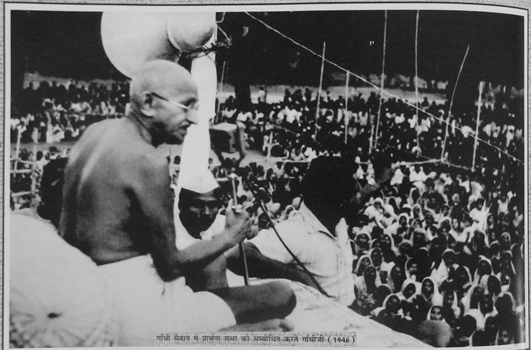
Figure 1: Mahatma Gandhi attending a prayer meeting at Gandhi Maidan, 1946
The International Day of Non-Violence thus stands as both a national homage and a global call to action. It reminds us that Gandhi’s message is not confined to the past but continues to light the way towards a world where peace triumphs over conflict, dialogue over division, and compassion over fear.
The Birth of Satyagraha
Mohandas Karamchand Gandhi, an attorney by profession, was in South Africa in 1893 to attend to a legal matter. He was on a Pretoria-bound first-class coach and asleep in his berth when a fellow passenger noticed his appearance and, seeing that he was a ‘coloured’ man, reacted with prejudice.
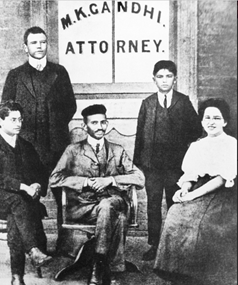
Figure 2: Gandhi (3rd from left) with his colleagues outside his office in Johannesburg in 1905
Gandhi was ordered to move from the first-class compartment to the van compartment, a directive he firmly refused. As a result, he was forced to spend the bitterly cold night at Pietermaritzburg station. The following morning, he took the next available train to Pretoria.
"The hardship to which I was subjected was superficial — only a symptom of the deep disease of colour prejudice. I should try, if possible, to root out the disease and suffer hardships in the process," Gandhi wrote about the incident in his autobiography "The Story of My Experiments with Truth" published in 1926.
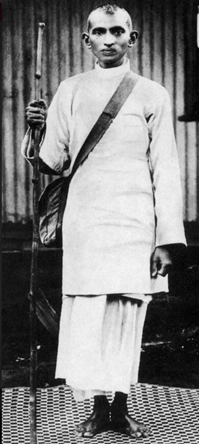
Figure 3: Gandhi as a "Satyagrahi" in South Africa
The following day, while traveling by stagecoach from Charlestown to Johannesburg, Gandhi was denied a seat inside with the white passengers and was instead forced to sit on the coachbox next to the driver. Later, he was ordered to sit on a dirty sackcloth on the footboard. When Gandhi refused to comply, he was brutally assaulted.
Gandhi heard similar tales from other Indians living in apartheid South Africa. Outraged by the discriminatory treatment of Indians and other people of colour under South Africa’s colonial administration, Gandhi mobilised fellow social workers and led a series of protests against the oppressive regime, even getting arrested in the process. It was during this period that Gandhi coined the word “satyagraha” — derived from "satya" (truth) and "agraha" (insistence), which also included his political philosophy of non-violent resistance.
“Non-violence is the greatest force at the disposal of mankind. It is mightier than the mightiest weapon of destruction devised by the ingenuity of man,” Gandhi wrote in Young India in 1920
Whether during the Dandi March of 1930, when thousands walked to the sea to break the salt law, or in the Quit India Movement of 1942, when an entire nation rose in unison, Mahatma Gandhi showed that moral force could stir millions without a single weapon raised.
And his message travelled far beyond India’s shores. Inspired by the Mahatma, Martin Luther King Jr. in America and Nelson Mandela in South Africa found the strength to challenge racism and apartheid. Across cultures and generations, his philosophy has endured, reminding humanity that non-violence is not a weakness but the most revolutionary power of all.
Gandhi at the UN: The Fifth Ahinsa Lecture
The Fifth Ahimsa Lecture, part of an ongoing series of lectures focused on non-violence, was last organised in September 2022 at the United Nations by UNESCO’s Mahatma Gandhi Institute of Education for Peace and Sustainable Development (MGIEP) in partnership with India’s Permanent Mission. It brought Gandhi’s philosophy vividly to life. Centred on the theme “Education for Human Flourishing”, the event stressed that true learning must nurture the body, mind, and spirit, and cultivate empathy and moral imagination alongside knowledge. A highlight was the use of a life-size hologram of Mahatma Gandhi, which conveyed his reflections on education and non-violence — a blend of tradition and technology that left a striking impact.
The lecture drew participation from India’s Permanent Representative to the UN, Ambassador Ruchira Kamboj, global eminent voices like Bernice King (daughter of Martin Luther King Jr.), youth representatives, and education experts who emphasised that Gandhi’s ideals remain a vital source of guidance for building peaceful, compassionate, and inclusive societies, especially at a time when education is being redefined as a tool for human flourishing rather than mere economic advancement.
Government Initiatives Based on Gandhian Philosophies
Just as Gandhi’s railways journeys helped him understand India’s diverse needs, modern India has translated his core philosophies into comprehensive national programmes that address the very issues he championed.
Government Initiatives Based on Gandhian Philosophies
|
Initiative
|
Launch Date/Details
|
Gandhian Philosophy
|
Key Statistics & Achievements
|
|
Swachh Bharat Mission
|
Launched on Gandhi Jayanti 2014
|
"Cleanliness is next to godliness"
|
• India declared Open Defecation Free on October 2, 2019 (Gandhi's 150th birth anniversary• 5,66,068 ODF+ villages (as of Aug 13, 2025)• More than 12 crore toilets constructed• 3 lakh children under age 5 lives saved (WHO data)
|
|
Self-Help Groups (SHGs)
|
Under Deendayal Antyodaya Yojana – National Rural Livelihoods Mission (DAY-NRLM)
|
Cooperative economics and grassroots empowerment
|
• Rs. 11,10,945.88 crore cumulative loans disbursed to women SHGs • 10.05 crore women mobilized into 90.90 lakh SHGs (as of June 2025)• Target of mobilizing 10 crore rural households achieved
|
|
SVAMITVA Scheme
|
Launched 2020 on National Panchayati Raj Day
|
Village self-reliance and Panchayati Raj
|
• 65 lakh property cards distributed • 50,000+ villages covered • Drone surveys in 3.20 lakh villages completed
|
|
Khadi and Village Industries
|
Ongoing promotion through KVIC
|
Swadeshi philosophy and village-based production
|
In the last 11 years, Production: 4x increase Sales: 5x increase Employment: 49% increase
Overall Sector (FY 2024-25): • Total production: Rs 1,16,599 crore • Total sales: Rs 1,70,551 crore • Employment: 1.94 crore people
Khadi Sector Specific: • Production: Rs 3,783 crore • Sales: Rs 7,145 crore • Employment: more than 5 lakh people PMEGP: • Over 10 lakh units set up • Employment to 90 lakh people Women Empowerment: • 57.45% of 7.43 lakh trainees (last decade) are women • 80% of 5 lakh Khadi artisans are women • Artisan wages increased by 275% in last 11 years
|
|
PM Janjatiya Unnat Gram Abhiyan (PM JUGA/DAJGUA)
|
Launched October 2, 2024 from Hazaribagh, Jharkhand by PM Modi
|
Tribal community advancement for national development
|
• Financial outlay: ₹79,156 crore (Union Govt contributing ₹56,333 crore) • Benefits over 5 crore tribal citizens • Covers 63,000 villages in 549 districts (71% of country) • Implemented through 17-line ministries
|
|
Mahatma Gandhi National Rural Employment Guarantee Act
|
Ongoing
|
Right to dignified work and inclusive rural development
|
• 3.83 crore households availed employment • 106.77 crore person-days generated in FY 2025-26 (as of July 21, 2025)
|
Contemporary Global Relevance of Gandhi
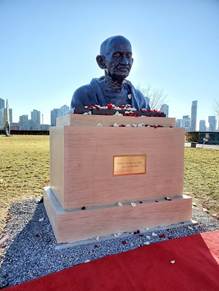
Addressing modern crises: Gandhi's philosophy of non-violence remains crucial for tackling today's challenges including violent conflict, terrorism, economic inequalities, pandemics and climate change.
UN Founding Principles: UN Secretary-General António Guterres noted that Gandhi's vision forms key pillars of UN work, with his ideas foreshadowing the 2030 Agenda for Sustainable Development. Gandhi championed sanitation, maternal health, education, gender equality, hunger reduction, and development partnerships long before the SDGs were designed. Guterres emphasized that non-violence is a powerful tool for justice requiring courage and collective resolve.
This enduring relevance is reflected in global policy frameworks and how Gandhi's transformative journeys continue to be commemorated.
International Recognition and Collaboration
G20
During the 2023 G20 Summit in New Delhi, leaders from across G20 member nations and international organisations gathered at Raj Ghat, Mahatma Gandhi’s samadhi, to pay tribute. In his public message following the visit, PM Modi called Gandhi “the beacon of peace, service, compassion and non-violence,” highlighting that the Mahatma’s timeless ideals continue to guide global aspirations for a harmonious and inclusive future.
This act of homage wasn’t just ceremonial. It sent a strong, unified signal that amid competing geopolitical pressures and global challenges, there remains a place for Gandhi’s non-violent philosophy in international diplomacy.
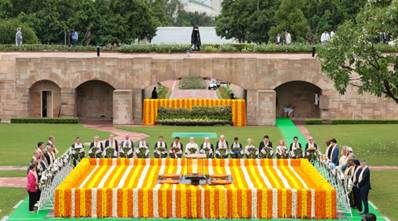
Figure 4: World leaders paid homage to Mahatma Gandhi at Rajghat during
India's Presidency of G20
International Memorials and Commemorations
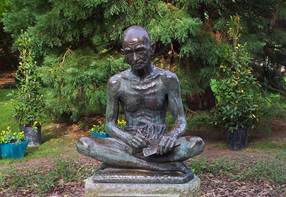
Figure 5: Park Marie Josee in the Commune of Molenbeek in
Brussels houses one of the oldest statues of Mahatma Gandhi
in Europe. The statue, sculpted by the renowned Belgian artist
Rene Cliquet, was installed in 1969 to mark the 100th Birth
Anniversary of Gandhi
|
Country
|
Location/City
|
Type of Memorial
|
Description
|
|
Belgium
|
Brussels, Antwerp
|
Memorials
|
Serve as spaces for tributes and community gatherings
|
|
United States
|
Washington D.C.
|
Bronze statue
|
Located near Indian Embassy, symbolizes enduring legacy and moral influence
|
|
Spain
|
Madrid (Joan Miró Square), Valladolid, Burgos, Gran Canarias, Barcelona
|
Statues
|
Multiple locations across the country
|
|
Serbia
|
New Belgrade
|
Bust
|
Placed on street named after Gandhi, draws floral tributes on birth anniversary
|
|
Switzerland
|
-
|
Statues and busts
|
At Indian Embassy
|
|
Thailand
|
Bangkok
|
Cultural commemorations
|
Events and drawing competitions highlighting Gandhi's ideals
|
|
Kazakhstan
|
-
|
Anniversary gatherings
|
Birth anniversary events organized by Indian missions
|
|
Netherlands
|
The Hague
|
Gandhi March
|
Largest ever Gandhi March on October 1st, 2017 with over 800 participants to mark International Day of Non-Violence
|
Railway Coach Exhibition Honours Gandhi's Transformative Journeys
The Union Minister of Culture and Tourism Gajendra Singh Shekhawat inaugurated a special Railway Coach dedicated to Mahatma Gandhi at Gandhi Darshan, Rajghat, on Sept. 11, 2024 in New Delhi. The coach commemorates Mahatma Gandhi's journey and his enduring legacy.
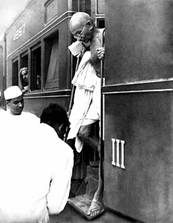
The exhibit features a meticulously restored railway coach from the era of Mahatma Gandhi, symbolising his famous train journeys that were instrumental in his mission to unite the nation and advocate for justice and equality. After spending years in South Africa leading various political movements, Gandhi moved back to India and travelled across the Indian subcontinent in third-class railway compartments to improve his understanding of India and his vision for a united nation.
"The railways were more than just a means of transportation for Gandhi, they were a vehicle for understanding India in its entirety," Vice Chairman of Gandhi Darshan Vijay Goel said during the inauguration.
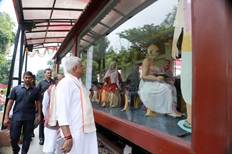
Conclusion
The International Day of Non-Violence commemorates Gandhi's transcendental vision and philosophies of non-violence, truth and social justice, which remain as relevant today as they were during his lifetime and are now internationally recognised as pivotal to the holistic and inclusive progress of humankind. The Government of India as well as the world continue to be inspired by his political and social vision to ensure that societies globally are peaceful, just, and compassionate – today and in the future.
SK/RK
References
Press Information Bureau:
Others:
Click here to see PDF
***
SK/SM
(रिलीज़ आईडी: 2173476)
आगंतुक पटल : 4225